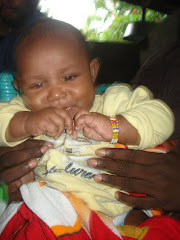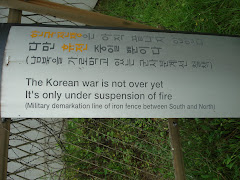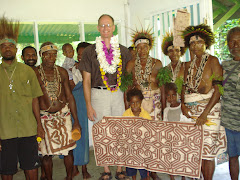
The Brothers in Brisbane entertained at a nursing home Sunday April 13. Pictured here from left to right: Br. Wade, a novice and fabulous singer, Br. Nathan-James who is a nurse and seminarian (and good singer too), and Br. Gabriel Maelasi, a Solomon Islander studying anthropology at the University of Queensland, where he also serves as a volunteer chaplain. Not pictured (because he was standing too far to the left) is Br. Lionel. (Okay, they are all good singers, which is why they are part of a choir...I don't mean to leave anybody out or infer judgments on their singing ability!) Lionel is looking forward to returning to his native Sri Lanka to set up an interfaith ashram. The other singers pictured are parishioners at St. Philip's Anglican Church which the brothers run in Brisbane. There are eight brothers at this friary, making it the largest house in this province. They also serve as doctors and nurses, teachers, they work with homeless and serve on boards for various institutions: a very well rounded, active group of brothers. I spent several days going around with them individually.
On April 15 I flew to Auckland, New Zealand, unaware that it is nearly two hours drive south to Hamilton, which has an airport too. We made it safely, and Wednesday morning I was given an official Maori "powhiri" or welcome. Hamilton is governed under a treaty signed during the reign of Queen Victoria according to which the pakeha (white) and Maori people cooperate. My arrival was an event for the whole community. My impression is that it was not about me, but about the deep and enduring affection for the Franciscan brothers living in this village. First a conch shell was blown by a young man in a feather decorated tunic, calling the people together. The Maori and other residents of the village stood inside a defined space, and I stood outside, accompanied by the Archbishop of New Zealand and several other Franciscan Tertiaries and friends who had come to Hamilton to meet me. Then another young man dressed as a warrior (that is to say with a leaf breech cloth) and wielding a very long club or spear danced the length of the ceremonial space. After several threatening moves, he cast a wooden dart on the ground before me and backed off, holding my gaze with his eyes and a stern frown. He held the spear at the ready. "Pick up the dart with your LEFT hand," the Archbishop instructed me. "your right hand means trouble!" Once I did this, a woman began singing a very beautiful song, and she was answered by the others in a call and response. Everyone was dressed in black signifying great formality. Apparently very few visitors are challenged with the dart, they only do this ritual for visitors judged to be very important. Finally the Archbishop and the young warriors guided me into the community house as everyone filed in singing. I was not permitted to take photos because the young men are part of a community based program for young offenders and their identities are protected.
Once inside the community house we heard six speeches. Mine was the only one in English. The entire event was conducted in Maori. I was impressed that all of the other pakehas (white people) understood Maori. Archbishop David Moxen whispered in my ear the gist of what each person was saying: all of them were putting my visit into context for the community, and showering praise on the Society of St. Francis. I was incredibly proud of my brothers for their long-standing and faithful ministry in New Zealand. After each speech (speeches were given by the men) members of the community, led by the women, would stand and sing a song to support the speaker.
When it was my turn to speak I spoke of my joy and gratitude for the welcome, and tried to put my ministry into the Franciscan and Gospel context, recognizing kinship with all people and the earth, praying for greater connection with indigenous peoples as we seek to discover new ways of being human on this fragile island home of ours. The Archbishop and others then surrounded me and started singing "Praise God from whom all blessings flow..." and the Maori's all sprang to their feet and joined in. It was a moment of joyful gratitude.
Concluding our ceremony I went to each man in the room and rested my forehead against his, and pressed my nose to his nose. We each breathed in and out, then I passed on to the next person. Behind me the other visitors lined up to do the same. The symbolism is that now we share the same breath, breathe the same air: we are connected. The women preferred air kissing and touching cheeks. Later it occurred to me perhaps I wasn't supposed to be so intimate with them and they were trying to cover my cultural gaffe. At any rate it was a profound experience of connection and grace.
But this wasn't all. There then followed a huge meal in another room, with more singing and speeches. What a beautiful welcome and affirmation of the Franciscan ministry here.






1 comment:
Dear Clark:
Greetings ...
Your reflection on your welcome ceremonies and visit to New Zealand seems to be right out of the movie "Whale Rider" ..
I think all your traveling as Franciscan "instrument of unity" will help us all on Long Island get a glimpse of the call to world wide community and show us how to "dialogue across differences."
"We have not been given a spirit of fear (i.e. specially in the face of Maori warriors with darts & tire irons) but of Love , Power and a Sound Mind".. I really think you will have lots of stories to share during your visit to SBU during the next Academic year .. I have already started planning your SBU welcome ceremony at the Wang and Sunita will help with the details.
Safe Travels as you return to the States and Little Portion Friary,,
Peace
Ed
Post a Comment